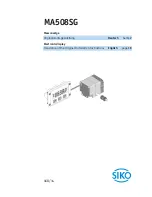
Page 16
Section 6 -
Serial & TCP Communication
6.1
Introduction
The CCD100 allows full control and feedback via TCP/IP and RS232 (via the USB port). All
controls via the HMI are also available via comms or on the webserver and all calibration is
also performed via comms commands or the webserver.
Please note that RS232 serial comms is only provided for legacy & debug purposes and is
not configurable. The fixed baud rate is 57600 with other settings as follows: 8 data bits, 1
stop bit, No parity, No handshaking.
TCP/IP comms requires an IP address and subnet mask to be configured for the CCD. This
can be set via the HMI. Note that on changing the IP address or subnet mask, the CCD
must be re-initialised by performing a system reset. This is done automatically if setting
from comms or the webserver (the CCD waits a second and then resets itself), but if setting
from the HMI, you must power off & on for the new TCP/IP settings to come into effect.
Note for the host connection, the TCP port of the CCD100 is port 101.
6.2
Command/Query format
The format of the commands and queries is common between all available comms
protocols for ease of use and understanding when switching between comms methods:
Format:
accc[?] [p][,p][,p]
¿
… where ‘a’ = address, ‘ccc’ = command/query, ‘?’ = query identification; ‘p’ =
parameter (separated by commas if more than one)
The first letter to be entered on the command line, before any command or query, is the
address identifier. The is a legacy character left in to provide some level of backwards
compatibility and familiarity with Chell’s remote comms protocol from earlier display
models. It can no longer be configured and is now fixed to the character ‘a’. On TCP/IP this
address doesn’t really mean anything because TCP/IP uses an IP address per unit for
identification.
Most commands are identified by three letters (although this is not always the case) and a
query is identified by following the command letters with a ‘?’ character. For all commands
with parameters, you must separate the command from its parameters with a space, and
separate multiple parameters with commas.
Table 1 in Appendix A summarises all commands and queries available. Note that where a
command is also a query, you do not enter any parameters for the query ‘version’ unless
explicitly stated in the table.
For everything sent on the comms port, the CCD will reply by informing the user of the
command/query it has just received, along with any parameters identified, any data
requested (if it was a valid command/query) and a line indicating whether the command
was accepted. This reply block is the same for anything sent to the CCD and is as follows.
(‘
¿
’ indicates a carriage return/line feed pair):















































